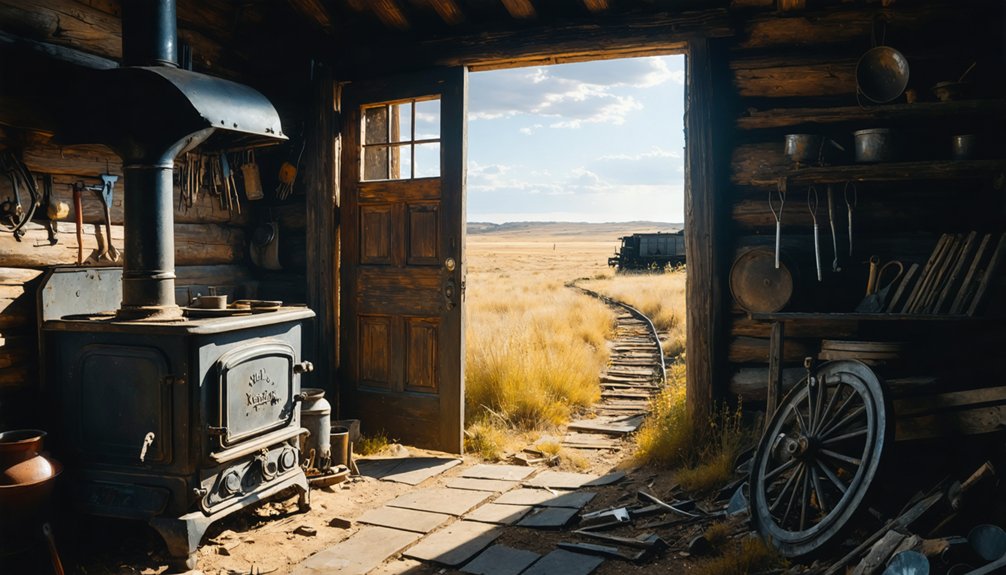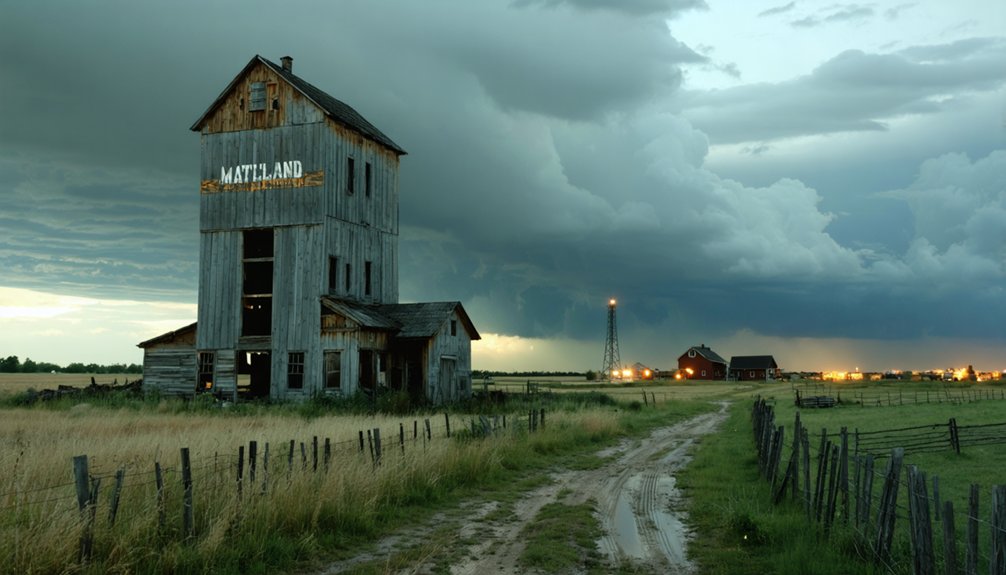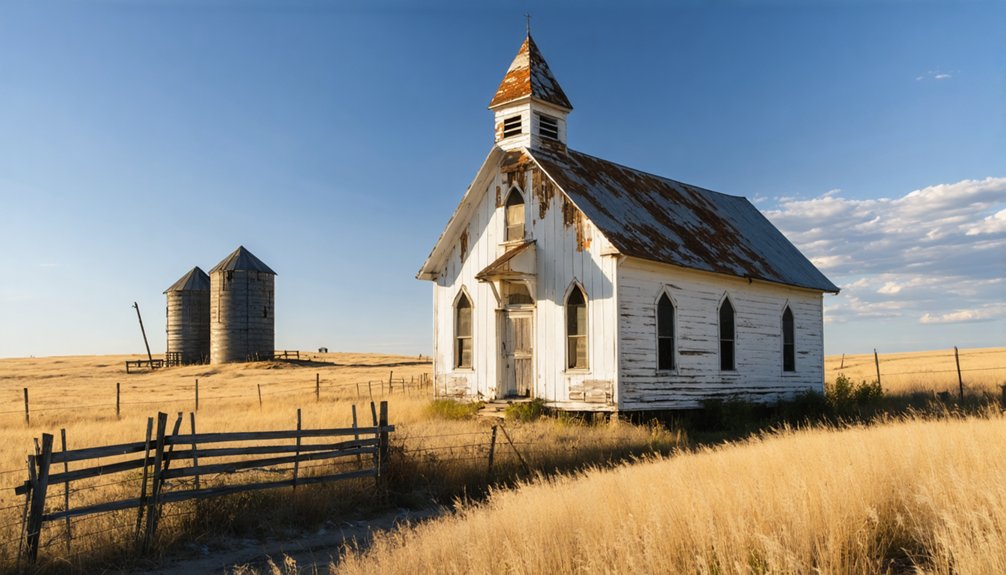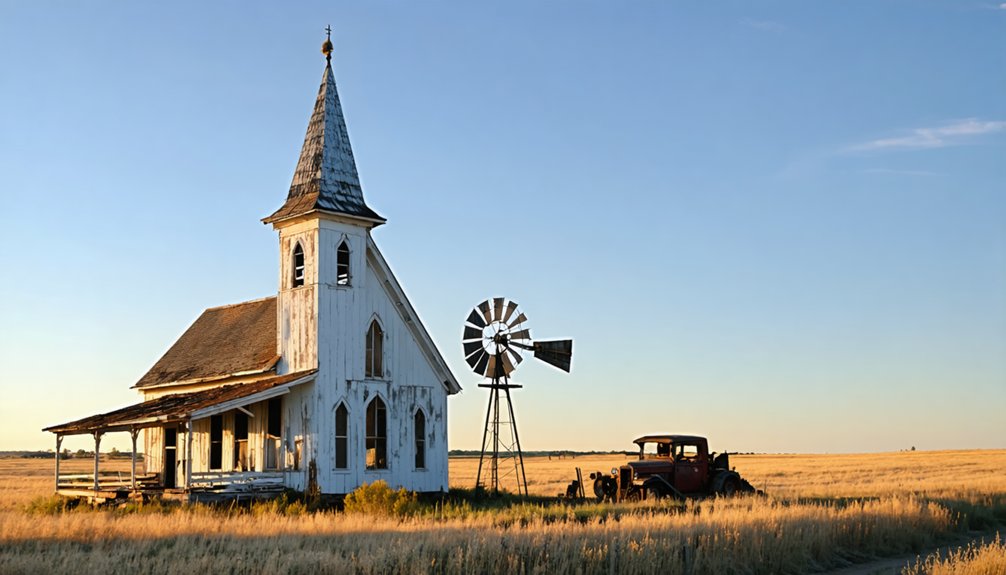You’ll find Maitland’s ghostly remnants just south of Deadwood, South Dakota, where this once-thriving mining town emerged during the Black Hills Gold Rush of 1877. Originally named Garden City, it was renamed in 1902 when Alexander Maitland acquired the Penobscot Mine and installed a 40-ton stamp mill. By 1915, the town boasted 50 homes and businesses before declining. Today, you can explore the historic foundations, Maitland’s house, and the livery barn while discovering a fascinating chapter of Black Hills mining history.
Key Takeaways
- Maitland was originally named Garden City in 1877 and renamed in 1902 after Alexander Maitland acquired the Penobscot Mine.
- The town flourished during mining operations with 50 homes, businesses, and a post office operating from 1902 to 1925.
- Mining operations ended in 1942 under War Production Board orders, leading to the town’s eventual abandonment.
- Today, Alexander Maitland’s house and livery barn remain standing among foundations and ruins of former buildings.
- The site is now managed by Homestake Mining Company as a timber farm, with historic structures accessible to visitors.
The Birth of Garden City in the Black Hills
While General Custer’s 1874 expedition sparked the Black Hills Gold Rush, it wasn’t until 1877 that Garden City emerged as a bustling mining settlement.
You’ll find this town’s origins deeply rooted in the dramatic cultural shifts that followed the discovery of gold in territory originally granted to the Lakota Sioux through the 1868 Fort Laramie Treaty.
Located just south of Deadwood, Garden City quickly attracted miners who developed sophisticated mining techniques to extract valuable ore worth $30 per ton.
Garden City’s miners pioneered advanced extraction methods south of Deadwood, pulling valuable ore from the Black Hills’ rich deposits.
The region’s transformation brought waves of European American settlers from the west and south, forever changing the sacred Black Hills landscape.
As miners poured in, Garden City grew into a thriving community, though its establishment came at the cost of displacing the indigenous Lakota people from their ancestral lands.
The growing settlement would later be renamed when Alexander Maitland took control of the prominent Penobscot Mine in 1902.
The influx of prospectors to the area began after Custer’s 1874 expedition confirmed the presence of gold deposits in the Black Hills.
From Garden City to Maitland: A Name’s Evolution
You’ll find the story of Garden City’s transformation begins in 1877 during the Black Hills Gold Rush, when prospectors first established this mining settlement.
The town’s identity shifted dramatically in 1902 when Scottish-born businessman Alexander Maitland took control of the Penobscot Mine and prompted the settlement’s renaming to Maitland.
Your journey through this ghost town’s history wouldn’t be complete without understanding how this name change marked a pivotal moment, as Maitland’s leadership sparked a mining revival that included a new 40-ton stamp mill and brought fresh prosperity to the area until 1915. The mill tragically met its end when it burned down in the 1950s. The town’s official presence continued through its post office until 1925.
Original Settlement Foundation Story
During the height of the Black Hills Gold Rush in 1877, prospectors and miners established Garden City as one of the original settlements in the bustling Deadwood-Two Bit mining district.
You’ll find that mining expansion drove the town’s strategic location, positioned near several productive mines including the Beltram, Columbus, Echo, Gold Eagle, and Penobscot.
While the settlement emerged alongside better-known camps like Central City and Deadwood, it maintained a smaller, more modest profile. By this time, gold production reached $1.5 million in the greater Deadwood Gulch area, fueling rapid development across the region.
The area would later become known for the Maitland Mine which produced 176,000 ounces of gold before shutting down in 1942.
Community resilience showed in the quick construction of basic infrastructure to support the growing population of miners and their families.
The town’s optimistic name reflected the era’s boundless hopes, though Garden City would remain overshadowed by its larger, more notorious neighboring settlements throughout the gold rush period.
Name Change Marks Revival
As Garden City’s mining prospects dimmed in the late 1800s, Scottish entrepreneur Alexander Maitland‘s acquisition of the Penobscot Mine in 1902 sparked a remarkable change.
The name change from Garden City to Maitland carried deep revival significance, marking the town’s resurgence as a mining hub. Like Ebenezer Howard’s vision of planned urban development, the transformation aimed to create an optimized community combining industry and living spaces.
The shift brought three key developments:
- Installation of a new 40-ton stamp mill, revolutionizing local ore processing
- Establishment of an official post office under the Maitland name, operating until 1925
- Growth to roughly 50 homes and businesses by 1915, reflecting renewed prosperity
This name symbolism represented more than just new ownership – it marked the community’s determined push toward economic revival, even as neighboring towns like Deadwood and Central City continued to dominate the region’s mining landscape.
Legacy Behind New Identity
While Garden City’s original name reflected the region’s natural beauty, its transformation into Maitland in 1902 carried deeper historical significance.
You’ll find that Alexander Maitland’s involvement with the Penobscot Mine marked a pivotal shift in the town’s economic legacy, bringing renewed energy to the mining district during the early 1900s.
The name change coincided with the establishment of a post office and the construction of a 40-ton stamp mill, symbolizing the town’s evolution from a gold rush settlement to an organized mining community.
This cultural heritage lives on through the remaining structures and mining equipment you can still discover today, offering a tangible connection to the Black Hills’ rich mining history.
Mining Operations and Economic Growth
In 1902, the Maitland Mine commenced operations in Lawrence County’s Lead District, becoming a significant contributor to South Dakota’s mining economy.
You’ll find that mining technology advancements, like Alexander Maitland’s 40-ton stamp mill in 1903, transformed the site’s production capabilities. The mine utilized replacement deposit mining methods to extract minerals efficiently.
Here’s how the mine shaped local growth:
- Rich ore deposits yielded $30 per ton, supporting about 50 homes and businesses by 1915.
- The mine’s operation under multiple owners, including Canyon Corp in the 1930s, provided economic sustainability despite challenges.
- Silver, gold, and tungsten extraction created jobs and attracted investment to the Black Hills region.
The mine’s success helped establish Maitland as a notable player in the broader Lead Gold District, though smaller than powerhouse neighbors like Deadwood and Lead.
Life in a Thriving Mining Community

If you’d visited Maitland during its peak years, you’d have found a bustling community of miners and their families gathering at general stores, boarding houses, and likely saloons after long days in the mines.
The town’s social fabric was woven through shared meals, local traditions, and informal gatherings that helped residents cope with the isolation and challenges of frontier life. Like many of the over six hundred ghost towns in the Black Hills region, Maitland’s vibrant community life eventually faded into history.
Community bonds were strengthened by the presence of essential services like the post office, which operated from 1902 to 1925, making Maitland a self-sufficient outpost in the Black Hills mining district.
Daily Mining Town Life
Life in Maitland during its mining heyday centered around the demanding rhythms of mineral extraction, where diverse groups of workers endured long hours at the Penobscot Mine and its 40-ton stamp mill.
If you’d lived in Maitland during the early 1900s, you’d have faced significant mining challenges while working with complex ore that required careful processing to extract $30 per ton in precious metals.
The social dynamics of your daily life would’ve revolved around a tight-knit community of about 50 homes and businesses.
- You’d have worked alongside miners, engineers, and traders in a bustling atmosphere.
- You’d have dealt with the constant noise of stamp mills crushing ore.
- You’d have navigated the tensions of labor disputes and corporate competitions common in Black Hills mining towns.
Community Spaces and Activities
Beyond the daily grind of mining operations, Maitland’s community spaces buzzed with activity during the town’s peak years from 1877 through the early 1900s.
You’d have found over 50 homes and businesses dotting the landscape, creating natural hubs for community interactions. While specific records of social gatherings are limited, you can imagine the post office serving as a central meeting point where residents exchanged news and connected with the outside world.
The town’s proximity to Deadwood and Central City meant you weren’t completely isolated, giving you the freedom to participate in larger social events nearby.
Though mining dominated daily life, the presence of electricity and telephone lines suggests Maitland’s residents enjoyed modern amenities that would’ve enhanced their social connections and community activities.
The Rise and Fall of Penobscot Mine
While the Black Hills Gold Rush brought numerous mining operations to South Dakota, the Penobscot Mine emerged as a notable player in the late 1870s within the Deadwood-Two Bit mining district.
Under Alexander Maitland‘s leadership in 1900, Penobscot operations expanded considerably, leading to the town’s renaming from Garden City to Maitland in 1902.
The mine’s journey through its peak and decline involved:
- Installation of a 40-ton stamp mill by 1903, showcasing the operation’s industrial might
- Extraction of rich gold and silver ore from Cambrian dolomites, though mining challenges included complex processing requirements
- Gradual decline until 1915, followed by a brief revival attempt in 1934 before final closure
The mine experienced its final chapter when Canyon Corporation attempted to revive operations in 1934, ultimately closing under War Production Board orders in 1942.
Neighboring Towns and Regional Impact

Throughout the Black Hills Gold Rush era, Maitland formed part of an interconnected network of mining settlements that included prominent towns like Deadwood, Lead, and Central City.
You’ll find these neighboring towns played distinct roles: Deadwood became a legendary Wild West destination, Lead housed the massive Homestake Mine, and Central City emerged as an early mining powerhouse that required federal peacekeeping during the Aurora-Keets conflicts of 1877.
While Maitland’s ore mills made it a significant processing hub for surrounding camps, the town never achieved the prominence of its larger neighbors.
Its regional connections, including nearby Two Bit and Myersville, created a web of economic activity that defined the area until declining mines led to Maitland’s abandonment around 1915.
What Remains: Modern-Day Ghost Town
Today in Maitland, South Dakota, you’ll find a handful of historic structures standing as silent witnesses to the town’s mining era.
Alexander Maitland’s house, the livery barn, and an old office building remain as the most prominent ghost town remnants, while scattered mining equipment tells the story of the town’s industrial past.
- The Homestake Mining Company now owns most of the land, operating it as a timber farm since mining operations ceased during World War II.
- You can explore foundations and ruins from over 50 former buildings that once made up this bustling community.
- While past attempts to create a living ghost town museum didn’t succeed, you’re free to walk among the historic structures and discover traces of the Black Hills Gold Rush era.
Planning Your Visit to Maitland

Planning a trip to Maitland requires careful preparation, as this remote Black Hills ghost town offers an authentic but rustic exploration experience.
You’ll find this historic mining site just south of Deadwood via Maitland Road near Blacktail. For successful ghost town exploration, pack plenty of water and wear sturdy hiking boots to navigate the uneven terrain dotted with stone ruins and mining relics.
The best time for your visit is spring through fall when weather conditions are favorable.
While exploring the scattered remains of 50 former buildings and the iconic 40-ton stamp mill ruins, remember to practice historical preservation by not disturbing artifacts.
Nearby Deadwood provides essential amenities and lodging, making it an ideal base for your Black Hills adventure.
Frequently Asked Questions
Are There Any Reported Paranormal Activities or Ghost Sightings in Maitland?
You won’t find documented ghost encounters or spectral sightings here. Historical records, local folklore, and academic research show no evidence of paranormal activity in this former Black Hills mining settlement.
What Happened to the Families Who Lived in Maitland After Abandonment?
You’ll find that family legacies scattered as residents moved to nearby mining towns like Deadwood and Lead. Most sought jobs in surrounding communities, while their community memories merged into broader Black Hills history.
Did Any Famous Outlaws or Historical Figures Visit Maitland?
You won’t find records of famous outlaw encounters in Maitland, though Alexander Maitland’s mine leadership represents the town’s most notable historical visit. The region’s Wild West legacy centered more on Deadwood.
What Was the Total Value of Gold Extracted From Maitland’s Mines?
You’d find that gold extraction from Maitland’s mines yielded roughly 176,000 ounces using various mining techniques, with the main Maitland mine producing 137,000 ounces of this impressive total.
Were There Any Major Accidents or Disasters Besides the Mill Fire?
From the available records, you won’t find any major Maitland accidents or ghost town disasters documented besides the 1950 stamp mill fire, though the area’s mining operations likely had routine workplace incidents.
References
- https://blackhillsvisitor.com/learn/maitland/
- https://westernmininghistory.com/towns/south-dakota/maitland/
- https://www.sdhspress.com/journal/south-dakota-history-2-2/some-black-hills-ghost-towns-and-their-origins/vol-02-no-2-some-black-hills-ghost-towns-and-their-origins.pdf
- https://www.sdpb.org/rural-life-and-history/2023-08-21/some-black-hills-ghost-towns-and-their-origins
- https://www.ghosttowns.com/states/sd/maitland.html
- https://en.wikipedia.org/wiki/List_of_ghost_towns_in_South_Dakota
- https://explore.digitalsd.org/digital/collection/WPGhosttown/id/4525/
- https://sdmineralindustries.org/education/Maitland
- https://www.deadwood.com/history/history-timeline/
- https://travelhummingbirds.wordpress.com/2019/08/16/a-brief-history-of-the-black-hills/



